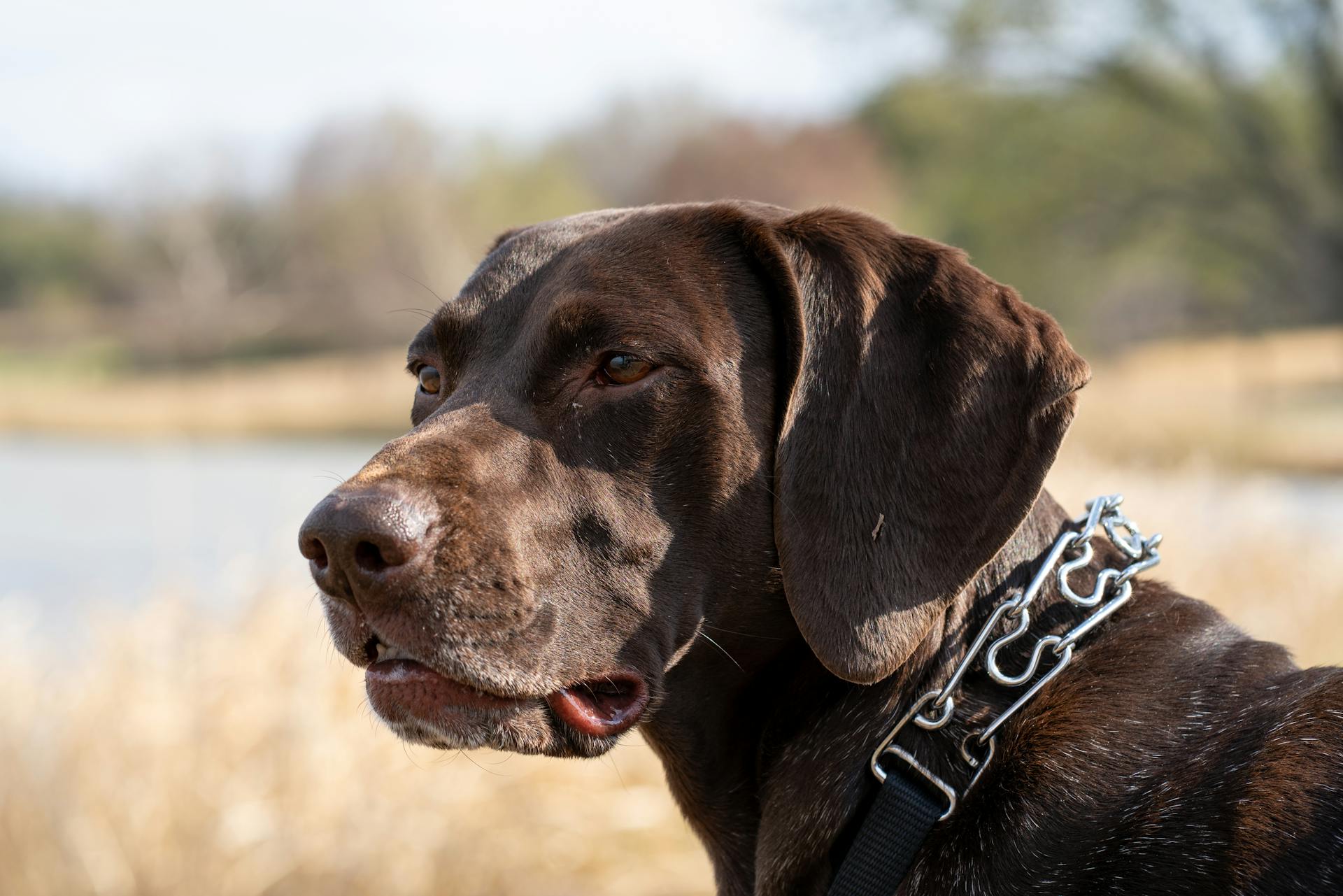
Female German Shorthaired Pointers are a delight to own and train. They are generally a healthy breed, but like all breeds, they can be prone to certain health issues.
Hip dysplasia is a common issue in German Shorthaired Pointers, and females are no exception. This can lead to arthritis and mobility problems later in life.
One of the best things about Female German Shorthaired Pointers is their intelligence and trainability. They are highly responsive to positive reinforcement training and thrive on mental and physical stimulation.
With regular exercise and mental stimulation, Female German Shorthaired Pointers can live a long and happy life, typically between 12-14 years.
Quick Facts
A female German Shorthaired Pointer typically stands between 21-23 inches tall.
These dogs weigh between 45-60 pounds, which can vary depending on their overall health and exercise level.
Female German Shorthaired Pointers are known for their friendly and intelligent nature, making them a great addition to active families.
They are relatively easy to train, but can be stubborn at times, so patience and consistency are key.
In terms of grooming, German Shorthaired Pointers have moderate needs, requiring regular brushing and nail trimming.
Here are some key statistics about female German Shorthaired Pointers:
- Height: 21-23 inches
- Weight: 45-60 pounds
- Lifespan: 12-14 years
- Exercise requirements: High
Health
Female German Shorthaired Pointers are generally a healthy breed, but like all dogs, they're prone to certain health conditions. Hip dysplasia is a condition where the hip joint doesn't develop properly, which can range from mild to severe cases.
Regular exercise is crucial for their well-being, and they thrive in homes with active individuals who have a spacious yard. Insufficient exercise can lead to nervousness and destructive behaviors.
Cancer is a concern for GSPs, with a higher incidence of certain cancers such as mammary tumors, mast cell tumors, and lymphosarcoma. Regular vet check-ups can help detect these conditions early on.
Von Willebrand's disease is a blood disorder affecting the clotting process, characterized by reduced levels of von Willebrand factor. Dogs with this condition may experience nosebleeds, bleeding gums, and prolonged bleeding after surgery.
Gastric dilatation-volvulus, also known as bloat or torsion, is a life-threatening condition that can occur in deep-chested breeds like GSPs. Immediate veterinary attention is necessary to prevent severe complications.
Proper diet, regular exercise, and regular vet check-ups can help ensure the well-being of your female GSP.
Consider reading: Bernese Mountain Dog Hip Dysplasia
Exercise and Training
To keep your female German Shorthaired Pointer fit and happy, she should get at least 1-2 hours of exercise daily. This can include long walks, jogs, hikes, or running off-leash in a safe area.
These dogs are true athletes who enjoy agility, field trials, dock diving, and tracking competitions, and they need a healthy outlet for their energy. If they don't get enough exercise, they'll get bored and frustrated, leading to destructive behaviors.
Meeting their daily exercise demands is a must, and it can be quite a commitment. To make the most of your time, consider training your dog in agility or other activities that challenge them physically and mentally.
You can also use obedience training to cultivate your dog's natural desire to please you. This will help her become an attentive and well-behaved companion.
A different take: Pembroke Welsh Corgi Agility
Exercise
Exercise is crucial for German Shorthaired Pointers, and they need at least 1-2 hours of it daily.

To keep them fit and happy, long walks, jogs, hikes, or running off-leash in a safe area are a must. Strolling around the neighborhood just won't cut it.
German Shorthaired Pointers are natural athletes who thrive on activities like agility, field trials, dock diving, and tracking competitions. If they don't have a healthy outlet for their energy, they'll get bored and frustrated, leading to destructive behaviors.
Meeting their daily exercise demands is a significant commitment, but it's essential for their well-being.
Training
Training is a breeze with a German Shorthaired Pointer (GSP). They have a strong desire to please their humans, which makes them highly trainable.
This breed was bred to be people-oriented, so they're naturally inclined to follow commands and obey rules. Early and ongoing obedience training will help you develop a well-behaved dog.
Their gun dog persona often leads to pointing behavior, which is a natural instinct for the breed. You may even see your puppy exhibiting this behavior on its own, with an intense gaze, lowered stance, and a "pointed" foreleg.
Suggestion: German Shorthaired Pointer Behavior Problems

However, their high prey drive can cloud their better judgment, leading to wild chases after cats or other small pets. Use caution when exercising them off-leash, and keep them in a securely fenced yard.
Recalls can be a challenge, but with consistent training, your GSP will learn to respond promptly to your commands.
Grooming and Diet
The German Shorthaired Pointer has a short, dense coat that sheds minimally and requires only occasional brushing. Regular brushing with a firm bristle brush once a week is sufficient to keep the coat in good condition.
Their smooth coat is relatively low maintenance and doesn't shed excessively, but it's essential to pay attention to their feet, particularly after exercise or field work, to prevent discomfort or potential issues.
A German Shorthaired Pointer's diet is relatively straightforward, but they do require a high-quality, high-protein dog food to meet their nutritional needs. You'll want to discuss your dog's specific dietary needs with your veterinarian to create a portion plan suitable for their age, weight, and activity level.
To maintain your GSP's overall health, it's crucial to monitor their food intake and avoid overfeeding. A recommended daily amount is 2 to 3 cups of high-quality dry food, divided into two meals.
Coat Color and Grooming
The German Shorthaired Pointer's coat is a beautiful thing, but it does require some attention to keep it looking its best. The GSP's coat is short and dense, providing excellent water resistance, and comes in a variety of colors including solid liver, liver with white markings, and roan patterns.
Regular brushing with a firm bristle brush once a week is sufficient to keep the coat in good condition. This will help to keep the coat shiny and prevent matting. I've found that a quick wipe with a grooming mitt is also effective, especially after a bath.
The GSP's coat sheds year-round, with seasonally heavier hair loss. You'll want to brush them every few days or as needed to keep the shedding under control. This will help to reduce the amount of hair that ends up on your furniture and clothes.
It's also essential to check your GSP's ears frequently and clean them as needed, especially if the dog plays outside often or swims. This will help to prevent infections and keep your dog's ears healthy and happy.
The GSP's nails should be kept trimmed short to prevent them from getting snagged and torn. This is an easy task that can be done at home with the right tools.
Worth a look: Will Shiba Inu Coin Reach .01
Diet and Nutrition
German Shorthaired Pointers are active dogs that need a high-quality, high-protein dog food to meet their nutritional needs.
A balanced diet is crucial for maintaining their athleticism and overall health.
Talk to your veterinarian to create a portion plan suitable for your dog's age, weight, and activity level. They can help you calculate how much your dog should eat based on these factors.
To avoid overfeeding, give treats in moderation and discourage your dog from gulping down their meal.
Running or high-intensity activity immediately after mealtimes should be minimized to prevent bloat.
A recommended daily amount for a German Shorthaired Pointer is 2 to 3 cups of high-quality dry food, divided into two meals.
The quality of the dog food you choose plays a significant role in nourishing your GSP, and higher-quality food can allow you to feed smaller portions while meeting their nutritional requirements.
To maintain your GSP in good shape, measure their food and offer it in two meals per day rather than free-feeding throughout the day.
If you're unsure whether your GSP is overweight, you can perform the eye test and hands-on test to check for excess weight.
Stock Photos

For those who love capturing the beauty of German Shorthaired Pointers, there are plenty of stock photo options available. You can browse over 3,300+ German Shorthaired Pointer stock photos and images.
German Shorthaired Pointers come in a variety of settings, from hunting to everyday life. You can find stock photos of them in fields, on white backgrounds, and even in the water.
If you're looking for a specific type of image, you can search for keywords like "german shorthaired pointer white background" or "german shorthaired pointer hunting." This will give you a wide range of options to choose from.
Some popular stock photo categories for German Shorthaired Pointers include:
- german shorthaired pointer white background
- german shorthaired pointer hunting
- german shorthaired pointer puppy
- german shorthaired pointer on white
Whether you're looking for a cute puppy photo or a hunting scene, there's a German Shorthaired Pointer stock photo out there for you.
Temperament and Compatibility
Female German Shorthaired Pointers love humans and bond closely with their families, but they have an independent streak that can make training challenging.
They require a lot of attention and can be demanding if they aren’t getting it, so be prepared to spend quality time with your female GSP.
In the right environment, German Shorthaired Pointers make amazing pets, especially for active owners who can keep up with their energetic and playful nature.
Female GSPs are loving and protective, but early socialization with other dogs is crucial to prevent aggression towards other dogs.
They may chase cats or smaller dogs due to their hunting ancestry, so it's essential to keep them separate from small exotic pets.
With proper motivation and guidance, they learn quickly and are excellent partners for those who enjoy hunting or participating in field trials and other canine sports.
Female GSPs can form strong bonds with children when raised together, but their exuberance may be too much for toddlers and younger children.
Proper supervision and training are key to fostering positive interactions between your female GSP, children, and other animals, ensuring a harmonious and safe environment for everyone involved.
See what others are reading: Why Are Labradors so Popular
Owning a Female German Shorthaired Pointer
Owning a female German Shorthaired Pointer requires a significant amount of exercise and physical activity to keep them happy and healthy. With their high energy levels, they need daily runs, hikes, or playtime in the backyard to prevent boredom and destructive behaviors.
Their strong hunting instincts can be a challenge, especially if you have small pets in the household. They may view them as prey, so it's essential to socialize them well and provide plenty of exercise to redirect their energy.
To manage their shedding, regular grooming is a must. They are heavy shedders, so be prepared to brush them frequently, especially during shedding season.
Owning Essentials
Before you bring a female German Shorthaired Pointer into your home, make sure your whole household is prepared for the new pet. You'll want to consider the exercise needs of your new companion, as they require plenty of physical activity to stay happy and healthy.
A unique perspective: Boston Terrier New England
Exercise is crucial for a German Shorthaired Pointer, and they need at least an hour of exercise per day. This can be a combination of walks, runs, and playtime in the yard.
Female German Shorthaired Pointers are intelligent and energetic, so be prepared to engage them in mentally stimulating activities to prevent boredom and destructive behavior.
German Shorthaired Pointers are social animals and require attention from their human family members. They thrive on interaction and can become lonely if left alone for too long.
You'll want to make sure your home is securely fenced to prevent your German Shorthaired Pointer from escaping, as they are prone to wandering off if they catch a scent.
For another approach, see: How Much Exercise Do Labrador Retrievers Need
Adopting or Buying a Dog
If you're looking to bring a female German Shorthaired Pointer into your life, you'll want to consider the cost of ownership. Puppies typically cost between $500 and $1,500, depending on their pedigree and availability.
It's essential to do your research and find a responsible breeder or rescue organization. You can start by contacting local rescue groups or breed organizations for assistance. German Shorthaired Pointer Club of America GSP Rescue and German Shorthaired Pointer Club of America Breeder Listings are great places to begin.
When searching for a breeder, don't be afraid to ask questions. You should be able to meet one or both parents of the litter and see clear medical test results for hips, elbows, and eyes.
If you're not set on buying from a breeder, consider adopting from a rescue organization. German Shorthaired Pointers can be high-energy dogs, so it's essential to find a responsible rescue group that can help match you with a dog that's a good fit for your lifestyle.
Here are some resources to get you started:
- German Shorthaired Pointer Club of America GSP Rescue
- German Shorthaired Pointer Club of America Breeder Listings
- AKC German Shorthaired Pointer Breeders
Final Thoughts
Owning a Female German Shorthaired Pointer is a big responsibility, and it's essential to know what you're getting into before bringing one home. German Shorthaired Pointers need plenty of exercise to keep their energy channeled appropriately.
They require a lot of patience and attention, which can be overwhelming for inexperienced dog owners. You need to be prepared to put in the work to keep your Female German Shorthaired Pointer happy and healthy.
It's crucial to understand that not every breed suits every living situation, and the German Shorthaired Pointer is no exception. They're not the dog for everyone, and it's essential to consider this before making a decision.
Welcoming a Female German Shorthaired Pointer into your home requires careful consideration of your lifestyle and ability to provide the necessary care and attention.
Frequently Asked Questions
How big do female GSP get?
Female German Shorthaired Pointers typically weigh between 45-60 pounds and stand 21-23 inches tall. They are a medium-sized breed, perfect for active families and hunters.
What is the lifespan of a GSP female dog?
A German Shorthaired Pointer female typically lives for 12-14 years, but individual lifespan can vary based on factors such as diet, exercise, and overall health. Proper care can help ensure a long and healthy life for your GSP.
What are the pros and cons of a German Shorthaired Pointer?
German Shorthaired Pointers are generally friendly and obedient, but may chase small pets due to their strong prey drive. With proper training and exercise, they can make wonderful companions for active families
Are male or female German Shorthaired Pointers better?
Both male and female German Shorthaired Pointers have unique traits, with males being more outgoing and aggressive, while females are fiercely protective of their litters
Sources
- https://dogtime.com/dog-breeds/german-shorthaired-pointer
- https://www.dogster.com/dog-breeds/german-shorthaired-pointer
- https://www.dogbreedinfo.com/germanshorthairedpointer.htm
- https://www.istockphoto.com/photos/german-shorthaired-pointer
- https://www.thesprucepets.com/german-shorthaired-pointer-dog-breed-profile-4777640
Featured Images: pexels.com


